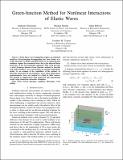Files in this item
Green-function method for nonlinear interactions of elastic waves
Item metadata
| dc.contributor.author | Demčenko, Andriejus | |
| dc.contributor.author | Mazilu, Michael | |
| dc.contributor.author | Reboud, Julien | |
| dc.contributor.author | Cooper, Jonathan | |
| dc.date.accessioned | 2020-02-14T16:30:02Z | |
| dc.date.available | 2020-02-14T16:30:02Z | |
| dc.date.issued | 2019-12-09 | |
| dc.identifier | 265915913 | |
| dc.identifier | d10836aa-97a3-4aaa-8120-370e0053a2f9 | |
| dc.identifier | 85077592032 | |
| dc.identifier | 000510220100476 | |
| dc.identifier.citation | Demčenko , A , Mazilu , M , Reboud , J & Cooper , J 2019 , Green-function method for nonlinear interactions of elastic waves . in Proceedings 2019 IEEE International Ultrasonics Symposium (IUS) . IEEE International Ultrasonics Symposium (IUS) , Institute of Electrical and Electronics Engineers Inc. , pp. 1859-1861 , 2019 IEEE International Ultrasonics Symposium (IUS) , Glasgow , United Kingdom , 6/10/19 . https://doi.org/10.1109/ULTSYM.2019.8926192 | en |
| dc.identifier.citation | conference | en |
| dc.identifier.isbn | 9781728145976 | |
| dc.identifier.isbn | 9781728145969 | |
| dc.identifier.issn | 1948-5719 | |
| dc.identifier.uri | https://hdl.handle.net/10023/19473 | |
| dc.description | Funding: UK Engineering and Physical Sciences Research Council Fellowship under Grant EP/K027611/1 and in part by the European Research Council advanced investigator award under Grant 340117. | en |
| dc.description.abstract | In the linear wave propagation regime, an analytical mesh-free Green-function decomposition has been shown as a viable alternative to FDTD and FEM. However, its expansion into nonlinear regimes has remained elusive due to the inherent linear properties of the Green-function approach. This work presents a novel frequency-domain Green function method to describe and model nonlinear wave interactions in isotropic hyperelastic media. As an example of the capabilities of the method, we detail the generation of sum frequency waves when initial quasi-monochromatic waves are emitted in a fluid by finite sources. The method is supported by both numerical and experimental results using immersion ultrasonic techniques. | |
| dc.format.extent | 3 | |
| dc.format.extent | 4750715 | |
| dc.language.iso | eng | |
| dc.publisher | Institute of Electrical and Electronics Engineers Inc. | |
| dc.relation.ispartof | Proceedings 2019 IEEE International Ultrasonics Symposium (IUS) | en |
| dc.relation.ispartofseries | IEEE International Ultrasonics Symposium (IUS) | en |
| dc.subject | Green functions | en |
| dc.subject | Nonlinear ultrasonics | en |
| dc.subject | Wave mixing | en |
| dc.subject | QC Physics | en |
| dc.subject | NDAS | en |
| dc.subject.lcc | QC | en |
| dc.title | Green-function method for nonlinear interactions of elastic waves | en |
| dc.type | Conference item | en |
| dc.contributor.institution | University of St Andrews. School of Physics and Astronomy | en |
| dc.contributor.institution | University of St Andrews. Centre for Biophotonics | en |
| dc.identifier.doi | 10.1109/ULTSYM.2019.8926192 |
This item appears in the following Collection(s)
Items in the St Andrews Research Repository are protected by copyright, with all rights reserved, unless otherwise indicated.

